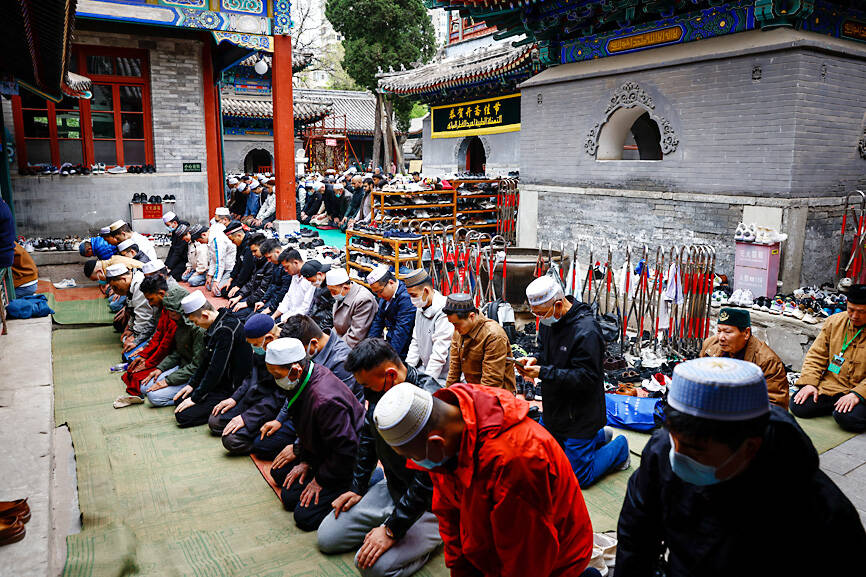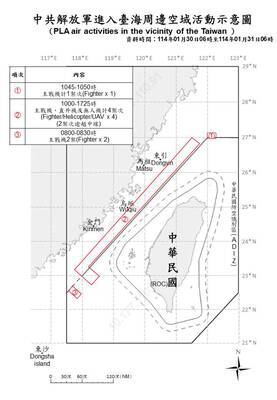The Chinese government has expanded its campaign of closing mosques to regions other than Xinjiang, where for years it has been blamed for persecuting Muslim minorities, Human Rights Watch said in a report released yesterday.
Authorities have closed mosques in the northern Ningxia region as well as Gansu Province, which are home to large populations of Hui Muslims, as part of a process known officially as “consolidation,” said the report, which draws on public documents, satellite images and witness testimonies.
Local authorities also have been removing architectural features of mosques to make them look more “Chinese,” part of a campaign by the Chinese Communist Party (CCP) to tighten control over religion and reduce the risk of possible challenges to its rule, it said.

Photo: EPA-EFE
Chinese President Xi Jinping (習近平) in 2016 called for the “Sinicization” of religions, initiating a crackdown that has largely concentrated on the western region of Xinjiang, home to more than 11 million Uighurs and other Muslim minorities.
A UN report last year found that China might have committed “crimes against humanity” in Xinjiang, including through its construction of a network of extrajudicial internment camps believed to have held at least 1 million Uighurs, Huis, Kazakhs and Kyrgyzs.
Chinese authorities have decommissioned, closed down, demolished or converted mosques for secular use in regions outside Xinjiang as part of a campaign aimed at cracking down on religious expression, Human Rights Watch said.
The Chinese Ministry of Foreign Affairs did not immediately answer faxed questions seeking comment on the report and its official policies toward Muslim minorities.
One of the first known references to “mosque consolidation” appears in an internal CCP document from April 2018 that was leaked to US media as part of a trove of documents known as the “Xinjiang Papers.”
The file instructed state agencies throughout the country to “strengthen the standardized management of the construction, renovation and expansion of Islamic religious venues” and stressed that “there should not be newly built Islamic venues” to “compress the overall number” of mosques.
“The Chinese government is not ‘consolidating’ mosques as it claims, but closing many down in violation of religious freedom,” said Maya Wang (王松蓮), acting China director at Human Rights Watch. “The Chinese government’s closure, destruction and repurposing of mosques is part of a systematic effort to curb the practice of Islam in China.”

UNITED: The premier said Trump’s tariff comments provided a great opportunity for the private and public sectors to come together to maintain the nation’s chip advantage The government is considering ways to assist the nation’s semiconductor industry or hosting collaborative projects with the private sector after US President Donald Trump threatened to impose a 100 percent tariff on chips exported to the US, Premier Cho Jung-tai (卓榮泰) said yesterday. Trump on Monday told Republican members of the US Congress about plans to impose sweeping tariffs on semiconductors, steel, aluminum, copper and pharmaceuticals “in the very near future.” “It’s time for the United States to return to the system that made us richer and more powerful than ever before,” Trump said at the Republican Issues Conference in Miami, Florida. “They

GOLDEN OPPORTUNITY: Taiwan must capitalize on the shock waves DeepSeek has sent through US markets to show it is a tech partner of Washington, a researcher said China’s reported breakthrough in artificial intelligence (AI) would prompt the US to seek a stronger alliance with Taiwan and Japan to secure its technological superiority, a Taiwanese researcher said yesterday. The launch of low-cost AI model DeepSeek (深度求索) on Monday sent US tech stocks tumbling, with chipmaker Nvidia Corp losing 16 percent of its value and the NASDAQ falling 612.46 points, or 3.07 percent, to close at 19,341.84 points. On the same day, the Philadelphia Stock Exchange Semiconductor Sector index dropped 488.7 points, or 9.15 percent, to close at 4,853.24 points. The launch of the Chinese chatbot proves that a competitor can

TAIWAN DEFENSE: The initiative would involve integrating various systems in a fast-paced manner through the use of common software to obstruct a Chinese invasion The first tranche of the US Navy’s “Replicator” initiative aimed at obstructing a Chinese invasion of Taiwan would be ready by August, a US Naval Institute (USNI) News report on Tuesday said. The initiative is part of a larger defense strategy for Taiwan, and would involve launching thousands of uncrewed submarines, surface vessels and aerial vehicles around Taiwan to buy the nation and its partners time to assemble a response. The plan was first made public by the Washington Post in June last year, when it cited comments by US Indo-Pacific Commander Admiral Samuel Paparo on the sidelines of the Shangri-La Dialogue

MARITIME SECURITY: Of the 52 vessels, 15 were rated a ‘threat’ for various reasons, including the amount of time they spent loitering near subsea cables, the CGA said Taiwan has identified 52 “suspicious” Chinese-owned ships flying flags of convenience that require close monitoring if detected near the nation, the Coast Guard Administration (CGA) said yesterday, as the nation seeks to protect its subsea telecoms cables. The stricter regime comes after a Cameroon-flagged vessel was briefly detained by the CGA earlier this month on suspicion of damaging an international cable northeast of Taiwan. The vessel is owned by a Hong Kong-registered company with a Chinese address given for its only listed director, the CGA said previously. Taiwan fears China could sever its communication links as part of an attempt